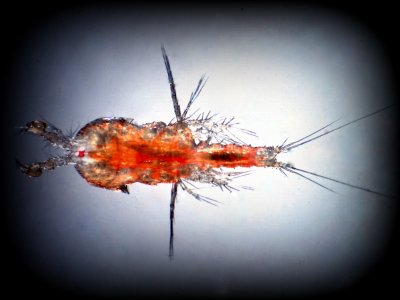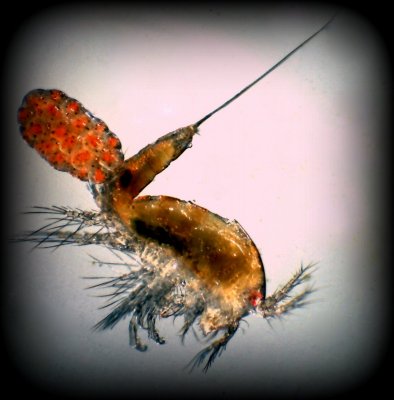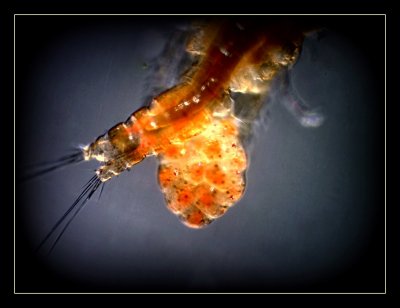Time for some myth busting!
One of my top frustrations is the myth that Tigriopus californicus are a "cold water species". I hear this from store owners and hobbyists ALL the time. This copepod is eurythermal. For those of you that don’t know the term, it describes an organism able to tolerate a wide range of temperatures. Tigriopus californicus is both euryhaline and eurythermal, withstanding and remaining active in salinities from 4ppt (Vittor 1971) to 102ppt (Egloff 1967) and temperatures from 4C (39.2F) (Vittor 1971) to over 40C (104F) (Ranade 1957). The genus Tigriopus is represented by seven species which are abundant in splash zone pools all over the world (Bradford, 1967).

This copepod can be quite successful in places where nothing else prospers. Tigriopus californicus, as an inhabitant of supralittoral rockpools, is subject to sudden and violent fluctuations in salinity and temperature; these conditions have eliminated this niche for most marine invertebrates (Ricketts and Calvin, 1973). It has effectively colonized much of the Pacific coast of North America. The marine harpacticoid copepod, Tigriopus californicus (Baker), is a successful colonizer of supralittoral splash pools from Torch Bay, Alaska, to Baja California, Mexico (L. Chalker-Scott 1995).

We (Reed Mariculture) are culturing these guys in a greenhouse in the San Jose, CA area. For those of you that have been there in the summer; it's hot. One of the main reasons we are working with this copepod is because we can culture them all year, even in the hottest months when the greenhouse temps get upwards of 38C (100F). I can assure you that we don't use chillers and don't air condition; that would cost us a fortune! If we had seasonality issues, you wouldn't see Tigger-Pods in stores in June, July, August & September, right? We have been culturing this species for 8 years now without any wild stock supplementation. They are fully adapted and domesticated to our greenhouse environment and all the seasonality issues that are associated with this kind of growing area.

Now, I can see how people could misunderstand this animal when they see it in a refrigerator in a pet store. The reason you see them held this way is because it makes more sense for a retail store; they can hold them for longer periods without heavy mortalities. The colder temperatures simply slow them down metabolically, keeping them from using up the oxygen and their energy reserves; plain and simple. Colder temperatures can also be advantageous with shipping this animal. They remain inactive at the colder temps while in shipping so that they don’t use up all the oxygen in the bottle. We use their hardiness to our advantage so that when a customer buys a bottle, the animals are alive and well.
I would like for everyone that reads this to share it and help me put this myth to rest. These animals are tougher than most people think, so let’s give them credit where it’s due!
Cheers!
Chad M. Clayton
One of my top frustrations is the myth that Tigriopus californicus are a "cold water species". I hear this from store owners and hobbyists ALL the time. This copepod is eurythermal. For those of you that don’t know the term, it describes an organism able to tolerate a wide range of temperatures. Tigriopus californicus is both euryhaline and eurythermal, withstanding and remaining active in salinities from 4ppt (Vittor 1971) to 102ppt (Egloff 1967) and temperatures from 4C (39.2F) (Vittor 1971) to over 40C (104F) (Ranade 1957). The genus Tigriopus is represented by seven species which are abundant in splash zone pools all over the world (Bradford, 1967).

This copepod can be quite successful in places where nothing else prospers. Tigriopus californicus, as an inhabitant of supralittoral rockpools, is subject to sudden and violent fluctuations in salinity and temperature; these conditions have eliminated this niche for most marine invertebrates (Ricketts and Calvin, 1973). It has effectively colonized much of the Pacific coast of North America. The marine harpacticoid copepod, Tigriopus californicus (Baker), is a successful colonizer of supralittoral splash pools from Torch Bay, Alaska, to Baja California, Mexico (L. Chalker-Scott 1995).

We (Reed Mariculture) are culturing these guys in a greenhouse in the San Jose, CA area. For those of you that have been there in the summer; it's hot. One of the main reasons we are working with this copepod is because we can culture them all year, even in the hottest months when the greenhouse temps get upwards of 38C (100F). I can assure you that we don't use chillers and don't air condition; that would cost us a fortune! If we had seasonality issues, you wouldn't see Tigger-Pods in stores in June, July, August & September, right? We have been culturing this species for 8 years now without any wild stock supplementation. They are fully adapted and domesticated to our greenhouse environment and all the seasonality issues that are associated with this kind of growing area.

Now, I can see how people could misunderstand this animal when they see it in a refrigerator in a pet store. The reason you see them held this way is because it makes more sense for a retail store; they can hold them for longer periods without heavy mortalities. The colder temperatures simply slow them down metabolically, keeping them from using up the oxygen and their energy reserves; plain and simple. Colder temperatures can also be advantageous with shipping this animal. They remain inactive at the colder temps while in shipping so that they don’t use up all the oxygen in the bottle. We use their hardiness to our advantage so that when a customer buys a bottle, the animals are alive and well.
I would like for everyone that reads this to share it and help me put this myth to rest. These animals are tougher than most people think, so let’s give them credit where it’s due!
Cheers!
Chad M. Clayton
- Bradford, J.M. (1967). Genus Tigriopus (Norman) (Copepoda-harpacticoida) in New Zealand with a description of a new species. Transactions of the Royal Society of New Zealand-Zoology, 10(6), 51.
- Egloff DA (1967) Ecological aspects of sex ratio and reproduction in experimental and field populations of the marine copepod Tigriopus californicus. Doctoral Thesis, Stanford University, Stanford, California.
- Ranade (1957). Observations on the resistance of Tigriopus fulvus (Fischer) to changes in temperature and salinity.
- Ricketts, E.F., Calvin, J., Hedgepeth, J.W., Phillips, D.W., (1985). Between pacific tides. Stanford University Press, Stanford, CA.
- Scott, L. C. (1995). Survival and sex ratios of the intertidal copepod, Tigriopus californicus, following ultraviolet-B (290–320 nm) radiation exposure. Marine Biology, 123(4), 799-804.
- Vittor, B. A. (1971). Effects of the Environment on Fitness-Related Life History Characters in Tigriopus californicus, Ph.D. dissertation, University of Oregon, Eugene.












